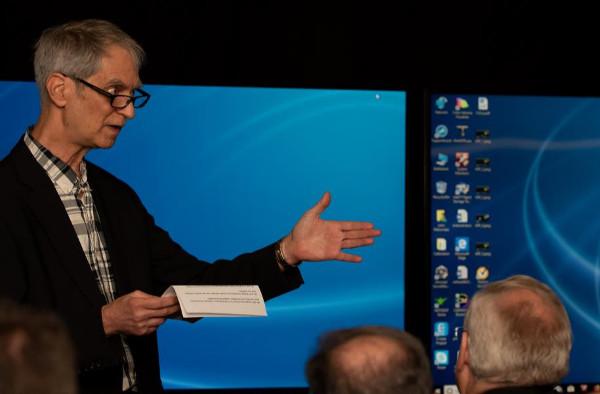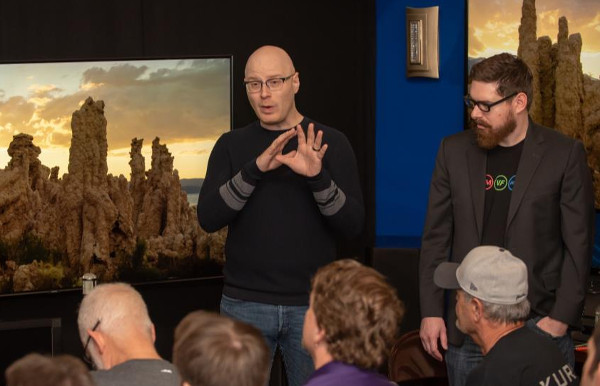Well, with a scoring difference of a mere 0.33 points, and with the Sony priced $1000 more than the LG, it looks like people who don't have barrels of cash on hand and want to save a little money while not sacrificing quality have their choice made. And why wasn't the bargain-priced ($2100) Vizio PQ65-F1 Quantum dot TV included in this shootout, which has a MSRP that's $1700 less than the Samsung QN65Q9FN Quantum dot model, and $1400 less than the Sony LED/LCD?
But I suppose paying $1000 more for a TV with no visible difference in quality might appeal to people who have already run out and bought that Sony "aspirational" digital music player for $8000. LOL!
Sony A9F OLED Crowned ‘King of TV’ at 2018 Shootout

Sony’s new XBR-65A9F 4K/Ultra HD OLED TV was declared the reigning “King of TV” by a panel of expert judges and video enthusiasts at the 14th Annual TV Shootout hosted by Scarsdale, NY-based AV retailer Value Electronics.
When the votes were tallied and all was said and done, Sony’s flagship OLED nudged out LG’s OLED65E8PUA by a hair.
Working in a carefully controlled environment, eight expert judges from all corners of the TV/video industry and invited video enthusiasts judged the performance of four flagship TVs — two OLED and two LED-backlit LCD models, all with 65-inch screens. Test samples were chosen randomly from Value Electronics’ inventory; no supplied samples were used.
The OLED models were LG’s OLED65E8PUA ($3,500) and Sony’s XBR-65A9F ($4,500). The LCD models were the Samsung QN65Q9FN ($3,800 but currently priced at $3,000 on samsung.com), and Sony’s XBR-65Z9F ($3,500).
The experts and video enthusiasts judged all aspects of picture quality for each TV, including contrast, color fidelity, color saturation, motion resolution, input lag time, and off-axis image quality. Test patterns and high-quality video clips were displayed and performance was judged pre- and post-calibration for day and night ambient-light viewing with a focus on high-dynamic-range (HDR) contrast, P3 color fidelity, color volume, and EOTF (electro-optical transfer function).
Sony’s XBR-65A9F was declared the overall winner based on the combined voting results from the expert judges and video enthusiasts. As shown in the tables below, TV performance was rated on a scale of 1 to 10 in each of 13 categories and results from the panel of experts were tabulated alone and then combined with results from the panel of video enthusiasts to determine the final pecking order.


Score totals across all categories for each TV are listed below and reveal a gap between the OLED and LCD models. OLED contenders took the lead in most of the voting categories — especially in HDR Reference mode — with Sony ultimately edging out LG by a mere 0.33 points.
110.66 - Sony’s XBR-65A9F OLED
110.33 - LG OLED65E8PUA OLED
105.86 - Sony XBR-65Z9F LCD
87.67 - Samsung QN65Q9FN LCD
Results were also tallied for each of the three primary test categories — SDR Day Mode/Video Processing, SDR Reference Mode, and HDR Reference Mode — to declare the Best Living Room TV, the Sony A9F; Best Home Theater TV, the Sony A9F; and Best HDR TV — a tie between the Sony A9F and LG’s E8P.
Commenting on test results, Robert Zohn, owner of Value Electronics and organizer of the TV Shootout, encouraged consumers to “use the voting results to assess which criteria are most important to them and review each category to determine the TV that best matches their priorities and viewing conditions.”
Test Setup and Methodology
All of the TVs under test were calibrated by professional calibrators using SpectraCal’s CalMAN software, a Konica/Minolta professional CS2000A spectroradiometer, Klein 10A colorimeter (profiled using the CS2000A spectroradiometer), and the new Konica/Minolta CA-410 color analyzer. Standard dynamic range (SDR), HDR, and Dolby Vision patterns were generated and fed from a Murideo SIX-G 4K Pattern Generator, and selections from an upcoming HDR test disc developed by Stacey Spears, co-founder of Spears & Munsil, creator of the Spears & Munsil High Definition Benchmark Blu-ray test disc.

For the evaluation session, the TVs were simultaneously fed a variety 4K streaming and other signals — including SDR and HDR test patterns, 1080p signals from Cable/DirecTV, and 4K video from Panasonic UB820 4K Blu-ray players — all running through an AVPro Edge professional HDMI distribution matrix switch. Sony’s BMV-X300 4K OLED professional color grading monitor was used as the reference against which all TVs were judged, and each of the TVs under test were visually matched to the BMV-X300’s white point.
Ethereal brand cables and interconnects from the Metra Home Theater Group were used for the evaluation setup, including Velox “true 24-bit” passive HDMI cables, which were paired with Ethereal’s HDM-GA1 Gigabit Accelerator.
The TVs were calibrated by David Abrams and John Reformato with supervision from Tyler Pruitt. The panel of experts included Rob Sabin, editor-in-chief at ProjectorCentral.com and former Sound & Vision editor; David Medina, HBO’s manager of media operations; Greg Tarr, managing editor of HDGuru; David Mackenzie, CEO of Fidelity in Motion; David Abrams, video systems specialist at Avical; Bill Schindler, display industry consultant; John Reformato, electrical engineer; and Steven Cohen, senior writer at High-Def Digest.
- Log in or register to post comments


The Shootout is for King of TVs... Not Bargain Bin's Best. You can't hold anything Vizio makes up to the TVs that were showcased here. That's not to say they are horrible TVs, but they aren't top tier or anything close to a contender for the title.

So, a TV should only be judged by its brand name and price? What quantifies "top-tier"? As a person who loves audio and video, I don't judge quality on whether a component has "Sony" or "Samsung" stamped on it; I judge by my eyes and ears. The Vizio Quantum has been written about for months, and has been posited as a lower-priced alternative to the expensive Samsung Q9 series. They should have at least been given a chance to compete. But if people who love audio and video are required to be snobs and only buy "top-tier" (which, by the many user reviews available, seem to have as many quality control and ergonomic problems as lower priced brands like Vizio and BIC America) products that are many times overpriced and overhyped, then count me out.

Darling you’re fixated on your own enemic wallet. I’m not talking price, I’m talking strictly performance. Nothing Vizio makes looks good if you scoot it up next to the TVs in the Shootout. As I said, that doesn’t mean it’s a trash TV. There are plenty of value/budget TVs that look okay and for a lot of people that’s more than fine. Basically what you’re doing is complaining that your Aeropostale clearance rack top isn’t on the runway in Milan or Paris for Fashion Week.
If you’re not interested in top performance or can’t afford top performance, then by all means count yourself out. For those of us who do care about the top performers, we will continue to watch the Shootouts. I have 2017s winner in a 65 inch.

Thank you so much for insulting the economic status of me and so many others on this site. It is always so nice to be put in our place by our "betters".
But your insults still don't answer the question: how can anyone know if those "POS Vizios" are competitive if they are never tested against the TVs you rave about? And BTW: if Vizios are so damned awful and unworthy, then why does Value Electronics, the host of the shootout, even carry them, let alone as an authorized dealership? I have to wipe away my salted tears when I think of how their reputation must be sullied by such an action!

But Vizio has been in the Shootout before and guess what? They came dead last by a large margin. See the 2016 results for reference.
https://www.soundandvision.com/content/lgs-oled-wins-2016-value-electron...

this link shows the Vizio is in the same class as Sony and Samsung.

Love the panel of expert judges, starting with my man Rob Sabin (now rocking it at PJC), but the omission of Vizio's Quantum series cries out: brand/cost prejudice.
My only disagreement with the final conclusions is for "Best Living room TV". I would have selected Sony's Z9F above either of the OLEDs. A Real world living / family room environment usually means lots of natural sunlight most of the day.
Both LCD based TV's image are more striking in a natural sunlight environment.
I've viewed both of the OLED's (non calibrated) and I can distinguish the improved image quality (it's Sony's processor of course) of the A9F.

Obviously, because of its unavailability in the U.S. the latest Panasonic OLED was not in the mix, however, just a couple of months ago, in a shootout in Europe of similar models (but only OLEDs), done in a similar manner as above and including the Panasonic, largely because of its superior color accuracy, the Panasonic came out on top of them all.
Also, back a few months ago and although presently only available in a 55" model, interestingly enough, the Philips OLED won the battle.
Too bad for the potential purchasers, all of these OLED brands aren't available everywhere in the world.

I'd much rather have the judging done by 100 non "experts" in several uncontrolled lighting situations. The results would be far more more meaningful to actual buyers.

Yes, that could be an interesting perspective!
Hey, I love S & V, and the people who work there and test and review products do one helluva great job for us great unwashed out here in the land who cannot go to 47 different A/V stores to compare products because it is not economically feasible for us, or because A/V outlets are too far away, or because of limited mobility. They have the experience and they know what they are talking about, and they also have a job that just about every reader here is envious of: being able to audition all kinds of audio and video products on the market. But when we look for a new TV, we can't have 3 OLEDs and 3 LED/LCD sets sitting in our living rooms to make a comparison. The only thing we can really compare it to is the TV we own right at this moment that we are looking to replace.
Perhaps many of us cannot afford to buy the top-of-the-line models of audio/video equipment, but S & V helps with their test reports (which always have settings that, although S & V stresses they may vary with unit-to-unit samples, make a great starting point for making adjustments to the equipment. And their tips for improving your watching and listening environments also help immensely, although you would have to be fairly dense to think that any TV is going to look good with sunlight streaming into the window directly onto the TV screen, whether it be an OLED or an LED. I mean, some things are just common sense. That's what drapes and blinds is for, people! LOL!
But, like you said, it would be very interesting to see the perspective of an average (average, not stupid) A/V enthusiast and how they deal with uncontrolled lighting and listening situations to get the best results for their personal home theaters.

So unless you believe that the results were accurate to 4 significant figures (highly unlikely) this was actually a tie. Which is pretty much what you'd expect given Sony uses OLED panels manufactured by LG. So this is really a non-story.
The more interesting story to me is that it seems to confirm that with true high def (4K) high frame rate sources, the panel and not the signal path (i.e. TV processing) is mostly what matters.

























































